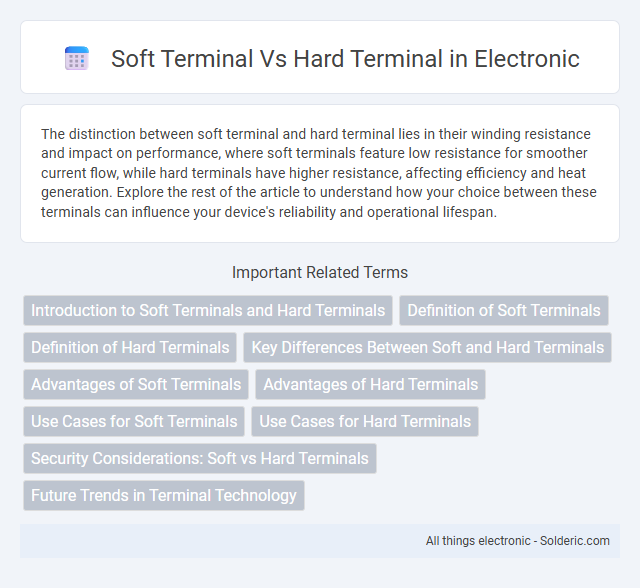The distinction between soft terminal and hard terminal lies in their winding resistance and impact on performance, where soft terminals feature low resistance for smoother current flow, while hard terminals have higher resistance, affecting efficiency and heat generation. Explore the rest of the article to understand how your choice between these terminals can influence your device's reliability and operational lifespan.
Comparison Table
| Feature | Soft Terminal | Hard Terminal |
|---|---|---|
| Definition | Software-based interface for telephony | Physical hardware device for telephony |
| Installation | Installed on computers or mobile devices | Requires dedicated hardware setup |
| Portability | Highly portable and accessible anywhere | Limited portability due to physical nature |
| Cost | Lower upfront cost, relies on existing hardware | Higher initial investment in physical devices |
| Flexibility | Supports updates and feature expansion easily | Limited flexibility; hardware upgrades needed |
| Performance | Depends on device and network capabilities | Often provides more stable and reliable connection |
| Maintenance | Software maintenance and updates required | Hardware repair and replacement may be necessary |
| Use Case | Remote work, mobile communication, softphone apps | Office desk phones, call centers, physical setups |
Introduction to Soft Terminals and Hard Terminals
Soft terminals are software-based systems that emulate traditional telephony hardware on digital devices, enabling flexible communication through applications without dedicated phone hardware. Hard terminals refer to physical devices such as desk phones or dedicated VoIP handsets designed specifically for telephony functions, offering tactile controls and consistent performance. Understanding the distinction helps optimize your communication setup by balancing flexibility and reliability.
Definition of Soft Terminals
Soft terminals refer to software-based interfaces that emulate traditional hardware terminals, allowing users to access mainframe or network systems through personal computers or mobile devices. Unlike hard terminals, which are physical devices with dedicated hardware, soft terminals leverage software applications to provide similar functionalities, including command input and data display. Your choice of soft terminal offers flexibility and cost efficiency by eliminating the need for specialized physical equipment while maintaining seamless connectivity.
Definition of Hard Terminals
Hard terminals are physical interfaces where a device directly connects to a network or system through tangible connectors such as RJ45 ports, USB plugs, or HDMI ports. These terminals ensure stable and reliable data transmission by establishing fixed electrical contacts. Understanding the role of hard terminals helps you differentiate between physical connectivity and software-based communication methods found in soft terminals.
Key Differences Between Soft and Hard Terminals
Soft terminals rely on software applications to emulate traditional hardware phones, enabling flexibility and remote access, whereas hard terminals are physical devices designed for dedicated use in fixed locations. Soft terminals require minimal initial investment and offer configuration ease, while hard terminals provide robust network reliability and consistent voice quality due to dedicated hardware. Security protocols differ as well; soft terminals depend heavily on firewall and encryption software, whereas hard terminals incorporate hardware-based security measures to prevent unauthorized access.
Advantages of Soft Terminals
Soft terminals offer significant advantages including cost-effectiveness by eliminating the need for dedicated hardware, which reduces setup and maintenance expenses. They provide enhanced flexibility, allowing You to access terminal services from multiple devices and locations using just software applications. Furthermore, soft terminals enable easy updates and scalability, improving overall operational efficiency and adaptability to evolving business needs.
Advantages of Hard Terminals
Hard terminals offer enhanced security through dedicated physical connections, reducing the risk of cyberattacks compared to soft terminals. They provide reliable performance with consistent connectivity and lower latency, crucial for high-volume transaction environments. You benefit from improved compliance with industry regulations due to their robust hardware-based encryption and auditing capabilities.
Use Cases for Soft Terminals
Soft terminals excel in remote customer service scenarios, enabling agents to handle calls via software on various devices without the need for physical hardware. They are ideal for call centers with remote or hybrid workforces, leveraging VoIP technology for cost-effective, scalable communication. Businesses use soft terminals to integrate with CRM systems, improving customer interactions through real-time data access and call management features.
Use Cases for Hard Terminals
Hard terminals are ideal for secure and reliable environments such as banking, healthcare, and government facilities where data integrity and protection are crucial. These devices provide dedicated hardware interfaces that ensure consistent performance and robust encryption standards, supporting mission-critical applications. Your organization benefits from enhanced security and reduced risk of cyber threats when deploying hard terminals in sensitive operational settings.
Security Considerations: Soft vs Hard Terminals
Soft terminals rely on software-based authentication and encryption methods, making them more vulnerable to malware and phishing attacks compared to hard terminals. Hard terminals use dedicated hardware components with tamper-resistant features, offering enhanced protection against physical and cyber intrusions. Security protocols in hard terminals typically include secure cryptographic modules and hardware security elements that safeguard sensitive payment data more effectively than software-only solutions.
Future Trends in Terminal Technology
Soft terminals leverage cloud computing and virtualization to enable flexible, software-based access to applications, driving innovation in remote work and IoT integration. Hard terminals continue to evolve with embedded AI and edge computing capabilities, enhancing performance for mission-critical industries like finance and healthcare. Emerging trends emphasize hybrid terminal solutions combining the adaptability of soft terminals with the reliability and security of hard terminals to meet evolving enterprise demands.
Soft terminal vs Hard terminal Infographic

 solderic.com
solderic.com